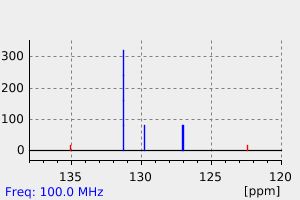1-(2,2-dichlorovinyl)-3-bromobenzene
中文名称
——
中文别名
——
英文名称
1-(2,2-dichlorovinyl)-3-bromobenzene
英文别名
1-bromo-3-(2,2-dichlorovinyl)benzene;1-bromo-3-(2,2-dichloroethenyl)benzene
CAS
——
化学式
C8H5BrCl2
mdl
——
分子量
251.938
InChiKey
AEDVEWISCOUNBQ-UHFFFAOYSA-N
BEILSTEIN
——
EINECS
——
-
物化性质
-
计算性质
-
ADMET
-
安全信息
-
SDS
-
制备方法与用途
-
上下游信息
-
文献信息
-
表征谱图
-
同类化合物
-
相关功能分类
-
相关结构分类
计算性质
-
辛醇/水分配系数(LogP):4.5
-
重原子数:11
-
可旋转键数:1
-
环数:1.0
-
sp3杂化的碳原子比例:0.0
-
拓扑面积:0
-
氢给体数:0
-
氢受体数:0
反应信息
-
作为产物:描述:ethyl 1-(3-bromophenyl)-2,2,2-trichloroethyl carbonate 在 2,2'-联吡啶 、 copper(l) chloride 作用下, 以 1,2-二氯乙烷 为溶剂, 反应 4.0h, 以85%的产率得到1-(2,2-dichlorovinyl)-3-bromobenzene参考文献:名称:β-(羰氧基)烷基:在铜(I)介导的1,1-二氯-1-烯烃的合成过程中,β-(酯)烷基自由基断裂的新子集摘要:提出了一个新的β-(酯)烷基自由基子集。这是对填充β-(酯)烷基自由基反应中迁移基团谱中间隙的β-(烷氧基羰基氧基)烷基自由基化学性质的首次研究。在迁移基团的光谱中,从较少的核真菌(乙酸盐)基团变为较高的核真菌(碳酸酯)基团的变化将反应路径从重排改变为片段化。该方法已用于高产率地合成1,1-二氯烯烃。二氯烯烃的形成是由于C的杂解导致烯烃自由基阳离子和碳酸根阴离子对(A CIP)的参与在β-(烷氧基羰氧基)烷基的β-位的碳酸酯的O键。通过与MeOH的亲核反应捕获烯基自由基阳离子以形成甲酯。DOI:10.1016/j.tetlet.2014.05.097
文献信息
-
A Novel Synthetic Approach to Dichlorostyrenes作者:Alexey V Shastin、Vasily N Korotchenko、Valentine G Nenajdenko、Elisabeth S BalenkovaDOI:10.1016/s0040-4020(00)00606-2日期:2000.8We found that N-unsubstituted hydrazones of aromatic aldehydes can be easily converted to the corresponding 1,1-dichlorostyrenes in the reaction with carbon tetrachloride using copper (I) chloride as catalyst. Factors affecting the route of the reaction and yields of the products were investigated. A proposed mechanism for the reaction is discussed.
-
The Use of Bromotrichloromethane in Chlorination Reactions作者:Mark Lautens、Stephen Newman、Christopher Bryan、Didier PerezDOI:10.1055/s-0030-1258368日期:2011.1Carbon tetrachloride is no longer used as a common solvent due to its toxicity and harmful environmental impact. The synthesis of gem-dichloroalkenes from aldehydes by using triphenylphosphine typically requires carbon tetrachloride as a solvent. We report that stoichiometric bromotrichloromethane in acetonitrile can be used in place of solvent quantities of carbon tetrachloride in this transformation
-
——作者:V. G. Nenajdenko、A. V. Shastin、V. N. Korotchenko、E. S. BalenkovaDOI:10.1023/a:1011377504491日期:——A new general one-pot preparative method for the synthesis of 1-aryl(hetaryl)-2,2-dichloroethenes from aldehydes was developed. The method involves successive conversions of the latter into hydrazones followed by treatment with carbon tetrachloride in the presence of copper(I) chloride.
-
SmI2-mediated elimination reaction of trichloromethyl carbinols: a facile method to synthesize vinyl dichlorides作者:Jian Li、Xiaoliang Xu、Yongmin ZhangDOI:10.1016/j.tetlet.2003.10.085日期:2003.12Samarium diiodide-mediated elimination reaction provides a simple and general method to synthesize vinyl dichlorides from trichloromethyl carbinols directly in good to excellent yields. (C) 2003 Elsevier Ltd. All rights reserved.
表征谱图
-
氢谱1HNMR
-
质谱MS
-
碳谱13CNMR
-
红外IR
-
拉曼Raman
-
峰位数据
-
峰位匹配
-
表征信息
同类化合物
(βS)-β-氨基-4-(4-羟基苯氧基)-3,5-二碘苯甲丙醇
(S,S)-邻甲苯基-DIPAMP
(S)-(-)-7'-〔4(S)-(苄基)恶唑-2-基]-7-二(3,5-二-叔丁基苯基)膦基-2,2',3,3'-四氢-1,1-螺二氢茚
(S)-盐酸沙丁胺醇
(S)-3-(叔丁基)-4-(2,6-二甲氧基苯基)-2,3-二氢苯并[d][1,3]氧磷杂环戊二烯
(S)-2,2'-双[双(3,5-三氟甲基苯基)膦基]-4,4',6,6'-四甲氧基联苯
(S)-1-[3,5-双(三氟甲基)苯基]-3-[1-(二甲基氨基)-3-甲基丁烷-2-基]硫脲
(R)富马酸托特罗定
(R)-(-)-盐酸尼古地平
(R)-(-)-4,12-双(二苯基膦基)[2.2]对环芳烷(1,5环辛二烯)铑(I)四氟硼酸盐
(R)-(+)-7-双(3,5-二叔丁基苯基)膦基7''-[((6-甲基吡啶-2-基甲基)氨基]-2,2'',3,3''-四氢-1,1''-螺双茚满
(R)-(+)-7-双(3,5-二叔丁基苯基)膦基7''-[(4-叔丁基吡啶-2-基甲基)氨基]-2,2'',3,3''-四氢-1,1''-螺双茚满
(R)-(+)-7-双(3,5-二叔丁基苯基)膦基7''-[(3-甲基吡啶-2-基甲基)氨基]-2,2'',3,3''-四氢-1,1''-螺双茚满
(R)-(+)-4,7-双(3,5-二-叔丁基苯基)膦基-7“-[(吡啶-2-基甲基)氨基]-2,2”,3,3'-四氢1,1'-螺二茚满
(R)-3-(叔丁基)-4-(2,6-二苯氧基苯基)-2,3-二氢苯并[d][1,3]氧杂磷杂环戊烯
(R)-2-[((二苯基膦基)甲基]吡咯烷
(R)-1-[3,5-双(三氟甲基)苯基]-3-[1-(二甲基氨基)-3-甲基丁烷-2-基]硫脲
(N-(4-甲氧基苯基)-N-甲基-3-(1-哌啶基)丙-2-烯酰胺)
(5-溴-2-羟基苯基)-4-氯苯甲酮
(5-溴-2-氯苯基)(4-羟基苯基)甲酮
(5-氧代-3-苯基-2,5-二氢-1,2,3,4-oxatriazol-3-鎓)
(4S,5R)-4-甲基-5-苯基-1,2,3-氧代噻唑烷-2,2-二氧化物-3-羧酸叔丁酯
(4S,4''S)-2,2''-亚环戊基双[4,5-二氢-4-(苯甲基)恶唑]
(4-溴苯基)-[2-氟-4-[6-[甲基(丙-2-烯基)氨基]己氧基]苯基]甲酮
(4-丁氧基苯甲基)三苯基溴化磷
(3aR,8aR)-(-)-4,4,8,8-四(3,5-二甲基苯基)四氢-2,2-二甲基-6-苯基-1,3-二氧戊环[4,5-e]二恶唑磷
(3aR,6aS)-5-氧代六氢环戊基[c]吡咯-2(1H)-羧酸酯
(2Z)-3-[[(4-氯苯基)氨基]-2-氰基丙烯酸乙酯
(2S,3S,5S)-5-(叔丁氧基甲酰氨基)-2-(N-5-噻唑基-甲氧羰基)氨基-1,6-二苯基-3-羟基己烷
(2S,2''S,3S,3''S)-3,3''-二叔丁基-4,4''-双(2,6-二甲氧基苯基)-2,2'',3,3''-四氢-2,2''-联苯并[d][1,3]氧杂磷杂戊环
(2S)-(-)-2-{[[[[3,5-双(氟代甲基)苯基]氨基]硫代甲基]氨基}-N-(二苯基甲基)-N,3,3-三甲基丁酰胺
(2S)-2-[[[[[((1S,2S)-2-氨基环己基]氨基]硫代甲基]氨基]-N-(二苯甲基)-N,3,3-三甲基丁酰胺
(2S)-2-[[[[[[((1R,2R)-2-氨基环己基]氨基]硫代甲基]氨基]-N-(二苯甲基)-N,3,3-三甲基丁酰胺
(2-硝基苯基)磷酸三酰胺
(2,6-二氯苯基)乙酰氯
(2,3-二甲氧基-5-甲基苯基)硼酸
(1S,2S,3S,5S)-5-叠氮基-3-(苯基甲氧基)-2-[(苯基甲氧基)甲基]环戊醇
(1S,2S,3R,5R)-2-(苄氧基)甲基-6-氧杂双环[3.1.0]己-3-醇
(1-(4-氟苯基)环丙基)甲胺盐酸盐
(1-(3-溴苯基)环丁基)甲胺盐酸盐
(1-(2-氯苯基)环丁基)甲胺盐酸盐
(1-(2-氟苯基)环丙基)甲胺盐酸盐
(1-(2,6-二氟苯基)环丙基)甲胺盐酸盐
(-)-去甲基西布曲明
龙蒿油
龙胆酸钠
龙胆酸叔丁酯
龙胆酸
龙胆紫-d6
龙胆紫







